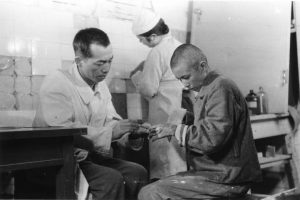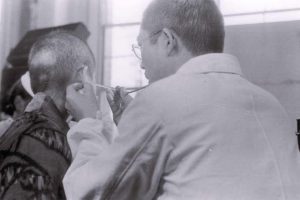Striving to fill voids in Hiroshima, evidence of victims remains―A-bomb victims in photos, Part 4: Physicians at Red Cross Hospital
Jul. 18, 2022
Continued treatment of wounded despite loss of family in A-bombing
by Kyosuke Mizukawa, Senior Staff Writer
Three years ago, Kenji Morita, 70, a physician who lives in Hiroshima’s Naka Ward, was struck by one of the photographs exhibited in the Hiroshima Peace Memorial Museum, located in Naka Ward. The museum was holding a special exhibit involving the Hiroshima Red Cross Hospital (now part of the same Naka Ward) that included materials showing how the hospital functioned as a center for relief activities after the atomic bombing. One of the photos showed a physician treating burns on a boy’s hand.
Remains of mother and younger sister never found
“I said, ‘I think I’ve seen him somewhere. Oh, it’s my father,’” remarked Mr. Morita at the time. His father, Yoshiyuki, a physician in the dermatology department at the Red Cross Hospital, passed away at the age of 80 in 1993. The photo was taken around October 5, 1945, two months after the atomic bombing, by the late photographer Shunkichi Kikuchi.
Mr. Morita said his late father had never mentioned details about what had happened in the bombing. Regardless, Mr. Morita identified himself to a curator at the museum, indicating that his father was the physician in the photo and conveying all of the information he did know. Yoshiyuki was an A-bomb survivor who had lost four members of his own family.
Mr. Morita’s family has been made up of physicians since Japan’s Edo period in history (1603–1867). Before World War II, his parents operated a clinic in what is now the area of Dobashi-cho, in Hiroshima’s Naka Ward.
On August 6, 1945, Yoshiyuki, then 33, experienced the atomic bombing at his home in the neighborhood of Hirano-machi (now part of Hiroshima’s Naka Ward), about 1.7 kilometers from the hypocenter. Fortunately, he was not seriously injured. However, his parents’ house, which was hit by the blast and thermal rays from the bombing at a location about 500 meters from the hypocenter, was destroyed along with the entire city. Present in the house at the time were Yoshiyuki’s mother, Emi, his younger brother, Chikayuki, and his younger sister, Shigeko.
Mr. Morita said, “I heard my father had pulled a two-wheeled cart while wandering around searching for his family.” He heard that the jawbone of Chikayuki, who was a pianist, had been found near the piano, which remained in the burnt ruins of his parents’ house. The remains of his mother and younger sister were never found.
Kazuyuki, Yoshiyuki’s other younger brother, was also killed in the bombing. Mr. Morita has never heard about the location at which Kazuyuki experienced the atomic bombing. However, a letter remains with which Kazuyuki had tried to contact his father from Hiroshima’s Koi neighborhood (now part of Nishi Ward), to where he had been evacuated.
Testimony and materials provide clues to identity
The letter was dated August 11. It was addressed to “Yoshiyuki Morita, Dermatologist, Red Cross Hospital.” In the letter, “I would like to get in touch with you somehow,” were some of the words written down hastily. “The whereabouts of mother, my older brother Chikayuki, and my older sister Shigeko are unknown, and I’m afraid they’re probably not alive. By some sort of miracle, I’m the only one alive. My legs are still not in good shape, though, so I haven’t taken one step outside.” Sometime later, Kazuyuki also apparently died.
Yoshiyuki opened a dermatology practice in Hiroshima in 1950 that Mr. Morita now operates. Looking at his father in the photo from the viewpoint of a dermatologist, he has a sense that the patient’s situation was serious. Mr. Morita said, “It looks to have been a serious burn, one that hadn’t healed even after two months. But it also seems as if there are few things in the room that could be used to treat the wound.”
Testimonies and materials of bereaved family members provide valuable evidence for understanding the stories behind Mr. Kikuchi’s photos. In some cases, the information regarding the physicians in the photos is obtained based on cooperation from the bereaved family.
Shigeru Doi, who passed away at the age of 77 in 1991, was photographed treating a patient in the Red Cross Hospital’s internal medicine department. No personal accounts of Mr. Doi were found, but his oldest son, Yoshiya, 73, a resident of Hiroshima’s Naka Ward, let this reporter read Mr. Doi’s application for an Atomic Bomb Survivor’s Certificate, which provided clues to his identity. Only surviving family members can obtain a copy by applying to the municipality that originally issued the certificate.
The application states that the hospital was full of the wounded even though there were no rooms available. It also indicates that Mr. Doi began to provide aid to the wounded on August 6 at the hospital, whose windows and walls were broken and destroyed. Mr. Doi had experienced the atomic bombing and fulfilled his work as a physician while serving as a witness to the devastation.
(Originally published on July 18, 2022)









